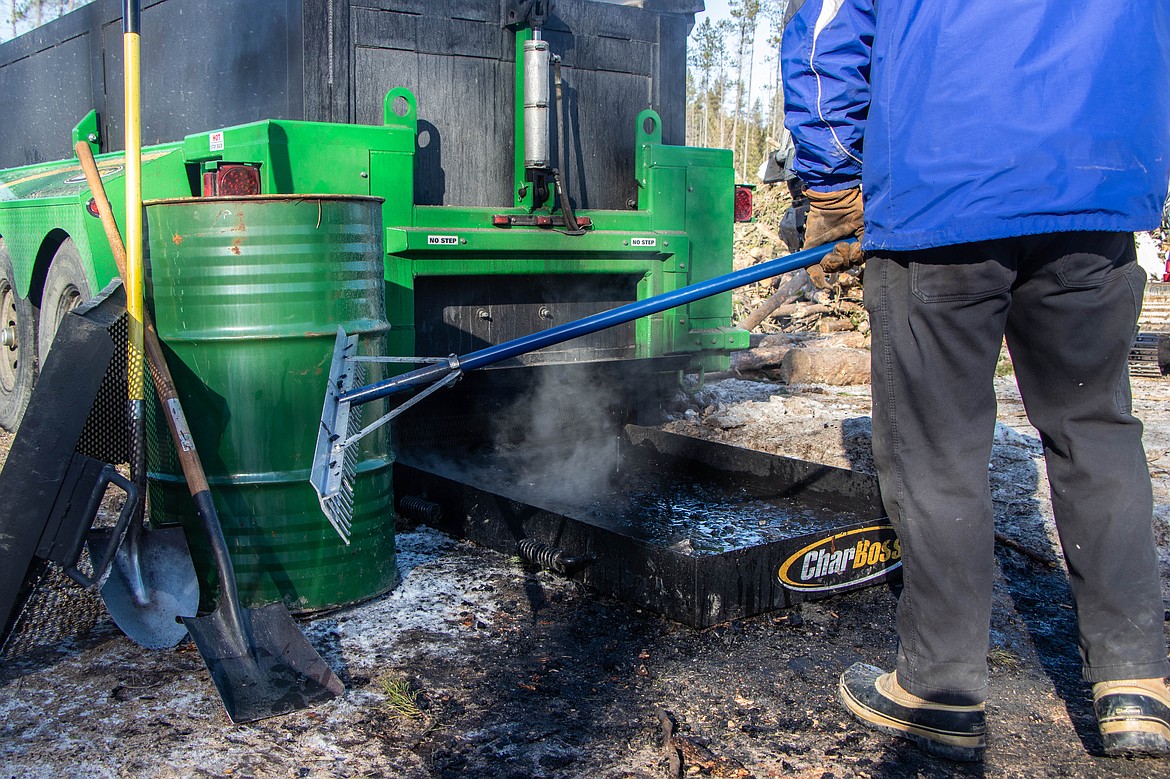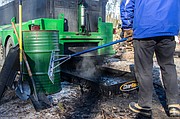New forest technology offers alternative to burning slash piles
Forest management activities are a major part of life in Northwest Montana; they create valuable products like lumber and employ many across the region.
But in the process, timber harvests also generate woody waste that has little economic value and act as fuel for wildfires, known as slash piles. Burning slash piles releases most of the wood’s beneficial carbon into the air through thick smoke and particulate matter; what’s left is ash.
That’s where the CharBoss comes in, and it just came to Montana.
The Forest Service, working with a private company in Naples, Florida – Air Burner, Inc. – created the mobile machine that converts the woody waste into biochar, a nutrient-rich product with restoration and enhancement potential, specifically in the soil.
Debbie Page-Dumroese, a researcher with the USDA Forest Service Rocky Mountain Research Station, is a leading expert in soil enrichment and the use of biochar. She helped develop and patent the CharBoss technology.
“This allows us to put a pulse of organic matter back into the soil so the soil can do everything we expect it to do,” Page-Dumroese said in an interview last week.
The Rocky Mountain Research Station and the Flathead National Forest showcased the machinery Feb. 16 during a presentation near Coram. Page-Dumroese was present at the event, among many other industry professionals and interested patrons.
A CharBoss will be used in the Lake Five and Coram area, and the data will be collected during the forestry work.
“The work that the Flathead will be doing here will be some of the first scientific data we have,” Page-Dumroese said at the event.
Scott Snelson, a district ranger in the Spotted Bear Ranger District of the Flathead National Forest, wanted the CharBoss to come to the Flathead because it helps with the adverse effects logging has on the climate and air quality.
“We have a lot of piles that we are essentially lighting and sending the majority of the carbon dioxide back into the atmosphere,” Snelson said. “This is a way for us to capture that material and turn it into stabilized carbon for our benefit.”
The event showed how the CharBoss – a dumpster sized machine that actually converts the slash into biochar – operates without an overuse of smoke, in turn creating nutrient rich, charcoal like material.
Biochar, according to the Rocky Mountain Research Station, can boost soil water holding capacity, promote vegetation growth, build landscape resistance and increase carbon sequestration potential in soil. They identified four main purposes for the product: agriculture, forest restoration, mine reclamation and tree nurseries.
The woody biomass that goes into the machine is leftover product from forest operations, like stems, limbs, leaves and other parts of trees. There is a motor across the top of the bin that creates an air curtain, preventing the smoke and particulates from escaping. An arm in the machine moves back and forth while the wood burns to move the overly burnt wood out of the way, preventing the creation of ash.
Page-Dumroese said the machines are helpful in wildfire mitigation work, especially in places where structures are nearby. The machines could be used by forestry departments, forestry contractors, or even compost facilities and landfills.
She also said that the machine can be replicated to a smaller version, such as a kiln or a small controlled fire pit.
The event in Coram showcased one of these kilns burning slash into biochar, a smaller option of the technology. While the kiln does not have an air curtain to avoid excess smoke, lighting it from the top down and off of the ground creates a flame cap that helps to keep more nutrients in and prevent the wood from burning down to ash.
“I started doing this a couple years ago and I have never had as many green beans as I do now using biochar,” Page-Dumroese said, talking about putting biochar into her garden soil.
There is some hesitation with the new product. Keith Hammer, who attended the event, said that there is worry that the biochar, by removing slash piles, will impact habitat and not help the forest in the greater context of carbon sequestration.
Hammer, Chair of the Swan View Coalition in Kalispell, an environmental group, worries that the new biochar binds up water and nutrients that plants need, in turn preventing those plants from getting those nutrients right away. He cites a paper written by Page-Dumroese from 2017, which can imply that in certain cases, leaving slash spread on the ground compares favorably to putting biochar on the soil.
Hammer noted that he recognized the machine is targeted toward slash caused by logging, but worried about the future and expense of removing all slash piles.
“Leave the forest alive and standing,” Hammer said. “... nature has been at this for a long time.”
Page-Dumroese recognized the concern, agreeing that slash piles can be habitat for animals like rabbits and gophers. But she assured that foresters are not going to burn all slash piles, mainly just the massive ones at log landings, specifically to help native vegetation grow faster on the sites.
According to Snelson, the CharBoss and biochar technology will improve the ecological base in Montana forests. He also noted that if we were to embrace the technology, “we could be a real climate leader.”
Rather than releasing the carbon dioxide back into the atmosphere, this technology lets people trap the material and turn it into stabilized carbon – improving the atmosphere and the soil, Snelson said.
Tim McEntire, a Northwest Region Representative with the Montana Logging Association, attended the event in Coram as well. He said that Montana loggers look forward to the continued push to diversify the lumber business.
“This is just another tool we can use,” McEntire said.



